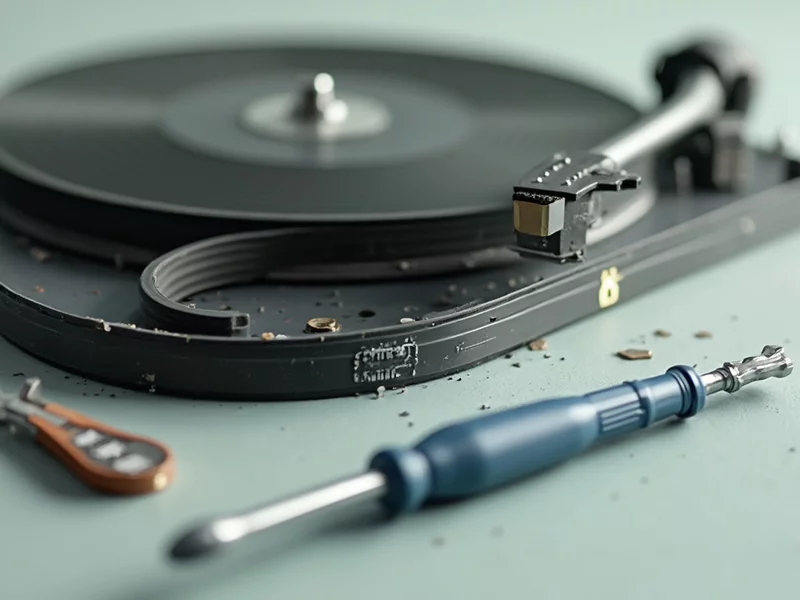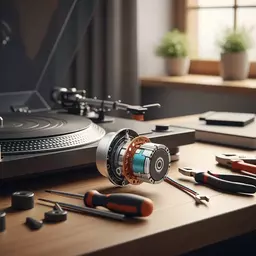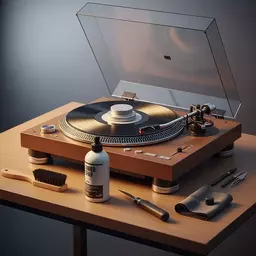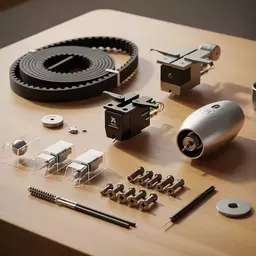Replace Your Turntable Belt Easily

Have you ever noticed how a small component like a turntable belt can drastically impact your listening experience? It’s often overlooked, but it plays a crucial role in maintaining sound quality. Let’s explore the essential insights about turntable belts that can elevate your vinyl enjoyment!
What You Will Learn
- The vital role of the turntable belt in connecting the motor to the platter for smooth playback.
- Key indicators that suggest your turntable belt may need replacement.
- How a worn belt can compromise audio quality and affect your records.
- Essential tools and materials needed for a successful belt replacement process.
- Factors to consider when selecting a new turntable belt for optimal performance.
- Research tips for understanding the specifications of different turntable models.
Turntable Belt Health Indicators and Impact
Understanding the signs of a worn turntable belt and its effects on audio quality is crucial for maintaining your record player. This visual summarizes the key indicators and their impact.
Signs Your Belt Needs Replacement
- • Slipping platter: Not spinning smoothly.
- • Uneven speed: Fluctuation in sound pitch.
- • Visible damage: Cracks, tears, or sticky texture.
Impact of a Worn Belt on Audio Quality
- • Distorted audio: Loss of clarity and detail.
- • Background noise: Unwanted hums or buzzes.
- • Record wear: Unnecessary wear on records and stylus.
Understanding the Importance of Your Turntable Belt
Every audiophile knows that a reliable turntable is at the heart of an exceptional audio experience. That’s why understanding the role of your turntable belt is crucial. The belt not only connects the motor to the platter, but it also impacts the overall performance of your beloved record player. A healthy belt can help ensure smooth playback and optimal sound quality. Let’s dive into why the turntable belt matters so much!
When you invest time and care into maintaining your turntable, you're investing in your entire listening experience. The belt is often overlooked, yet it’s a key player in keeping your records safe while spinning. If you want to savor the rich tones of analog sound, you’ll want to keep that belt in top shape!
Why the Turntable Belt Matters for Optimal Performance
The turntable belt serves as the vital link between the motor and the platter, allowing your records to spin at the correct speed. Without it, your music would sound distorted or even unplayable! So, why should you care about this humble piece of rubber? Here are a few reasons:
- Ensures accurate speed: A well-functioning belt keeps your records spinning at the optimal RPM.
- Prevents damage: A worn or broken belt can cause uneven rotation, which could lead to skipping or scratching your precious vinyl.
- Enhances sound quality: A good belt allows for smoother playback, preserving the nuances of your favorite tracks.
In essence, the turntable belt plays a pivotal role in the performance of your record player. Maintaining it is key to enjoying the high-fidelity sound we all love! For more foundational understanding of turntable mechanics, you can explore resources like Wikipedia's entry on turntables.
Signs That Indicate Your Turntable Belt Needs Replacement
Now that we understand the importance of the turntable belt, how do you know when it’s time for a replacement? There are several telltale signs that can indicate your belt might be in trouble:
- Slipping platter: If the platter is not spinning smoothly, this could be a sign of belt wear.
- Uneven speed: Notice any fluctuation in sound pitch? This might mean the belt is stretched out.
- Visible damage: Cracks, tears, or a sticky texture on the belt are clear indicators it's time for a change.
Being proactive about these signs can save your turntable from more severe issues down the line. Remember, prevention is better than cure!
The Impact of a Worn Turntable Belt on Audio Quality
A worn turntable belt can significantly compromise your audio experience. When that belt isn’t functioning as it should, you might start hearing those frustrating speed inconsistencies that disrupt the flow of your favorite records. Think of it like this: if the belt is struggling, so is the sound!
Here’s how a worn belt can affect your listening experience:
- Distorted audio: You may notice a loss of clarity and detail in the music.
- Background noise: A stretched or damaged belt can introduce unwanted hums or buzzes during playback.
- Record wear: When the platter doesn’t spin at the right speed, it can cause unnecessary wear on both your records and stylus.
Taking care of your turntable belt not only enhances your audio quality but also preserves the life of your favorite vinyl records. So, keep an eye (and ear) on that belt!
We Want to Hear From You!
What do you think about the importance of the turntable belt in your audio setup? Have you ever experienced issues due to a worn belt? Share your thoughts below:
Preparing for the Belt Replacement Process
Before diving into the nitty-gritty of replacing your turntable belt, it’s essential to prepare properly. Having the right tools and materials on hand can make the job go smoothly. Trust me, you don’t want to be scrambling for a screwdriver when you’re halfway through this process!
Gathering Tools and Materials for Your Turntable Repair
To get started, here’s a list of tools and materials I recommend you gather:
- Screwdriver set: A variety of sizes is best for different screws.
- Replacement belt: Ensure it's compatible with your specific turntable model.
- Cleaning cloth: For wiping down surfaces as you work.
- Isopropyl alcohol: Great for cleaning parts and ensuring a smooth fit.
- Protective gloves: Optional, but they can keep your hands clean!
Having these items ready will save you time and prevent unnecessary frustration. Plus, it will give you a sense of preparedness as you embark on this exciting journey of turntable repair!
Choosing the Right Turntable Belt: Key Considerations
When it comes to selecting the right turntable belt, a few factors can greatly impact performance:
- Size: Make sure the belt fits the circumference of your turntable’s platter.
- Material: Rubber belts are common, but some audiophiles prefer silicone for reduced friction.
- Brand compatibility: Always check that the belt is designed for your specific turntable make and model.
Choosing the correct belt is crucial for achieving optimal sound quality. A mismatched or worn belt can lead to speed inconsistencies, affecting your listening experience. So be sure to take your time on this step!
Understanding Different Turntable Models and Their Belt Specifications
Not all turntables are created equal, and their belt specifications can vary widely. Here are some tips to help you navigate this aspect:
- Research your model: Look up detailed specifications or manuals that outline the right belt size and type. For a broader understanding of electronic component standards, you might refer to resources from institutions like the IEEE (Institute of Electrical and Electronics Engineers) or the National Institute of Standards and Technology (NIST), which provide authoritative information on standards and technology.
- Join forums: Engaging with communities can uncover insights from others who have worked on the same model.
- Consult experts: If in doubt, don’t hesitate to reach out to Turntable Repair Australia for guidance!
Understanding your turntable's specifications ensures that when you do replace your belt, you’re doing it right the first time. You’ll avoid future headaches and get back to enjoying the beautiful analog sound you love!
Recap of Key Points
Here is a quick recap of the important points discussed in the article:
- The turntable belt is essential for ensuring accurate speed and optimal sound quality.
- Signs your belt may need replacement include slipping platters, uneven speed, and visible damage.
- A worn belt can distort audio, introduce background noise, and wear down your records.
- Preparation for belt replacement includes gathering necessary tools like screwdrivers and cleaning supplies.
- When choosing a replacement belt, consider size, material, and brand compatibility for optimal performance.
Frequently Asked Questions About Turntable Belts
Why is the turntable belt so important?
What are the common signs that a turntable belt needs to be replaced?
How does a worn turntable belt affect audio quality?
What tools and materials are needed for a turntable belt replacement?
What should I consider when choosing a new turntable belt?
Popular Posts
 Are you ready to elevate your turntable's performance? Understanding the nuances of motor replacemen
Are you ready to elevate your turntable's performance? Understanding the nuances of motor replacemen
 Have you ever wondered how a little maintenance can dramatically enhance your turntable's performanc
Have you ever wondered how a little maintenance can dramatically enhance your turntable's performanc
 Have you ever found yourself frustrated with a turntable that just won't play right? The good news i
Have you ever found yourself frustrated with a turntable that just won't play right? The good news i
 Have you ever considered how the condition of your tonearm affects the music you love? Proper tonear
Have you ever considered how the condition of your tonearm affects the music you love? Proper tonear
